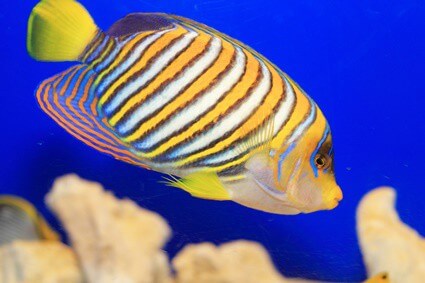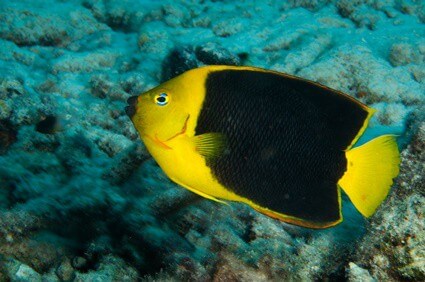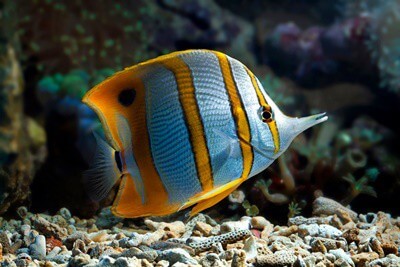Angelfish come in both freshwater and saltwater varieties. They call the tropical rivers throughout South America home, particularly the Amazon River. They also live in the reefs of the Indian, Pacific, and Atlantic Oceans. Here, they face many predators that rely on angelfish as a primary meal.
The main predators of angelfish include larger fish species, birds, sea mammals, aquatic reptiles, and amphibians. In the ocean, some angelfish are even hunted by humans. However, they mainly fear sharks, barracuda, and catfish. From the sky, they’re targeted by kingfishers, albatross, petrels, boobys, shearwaters, and other fishing birds. Some caiman and sea turtles will seek these fish out, as will dolphins or even bass.
Despite this, angelfish are not a helpless prey species. They protect themselves by freezing in place, fleeing, camouflage, and even fighting. This helps to keep most angelfish populations stable. There is only one known endangered angelfish species, the Vanderloos angelfish. There are only 1,500 mature individuals counted as of 2010, while 3 other species are also nearing dangerous levels.
What Animals Eat Angelfish?
The most common predator of angelfish is other fish. Since they share the same environments, this comes as no surprise. From sharks to catfish, angels must constantly be on the lookout for danger.
Worse yet, angelfish must also watch the skies and even land. Omnivorous and carnivorous marine animals will make a meal out of angelfish, including:
- Birds
- Sea mammals
- Aquatic reptiles
- Amphibians
Every species of angelfish, whether they’re freshwater or saltwater, have a natural predator. The only exception is the remarkable case of the Emperor Angelfish.
The Exception: The Emperor Angelfish
These saltwater angelfish do not have any known direct predators. The Emperor angelfish can be found primarily in the coral reefs of both the Pacific and Indian Oceans. This angelfish species can grow up to 15 to 16 inches in length.
Their size may contribute to their lack of predators. However, it is unclear what the direct reasons for this are.
With that said, opportunistic feeding is a common habit in the wild. Despite the lack of known predators to the Emperor angelfish, other creatures that target angelfish species can eat it. They just need to be large enough.
What Fish Eats Angelfish?
Freshwater angelfish have fewer predators than their saltwater cousins. That’s because the rivers of tropical South America are much smaller, and murky waters sometimes provide angelfish with cover. Even still, predators that routinely find and dine on angels include:
- Pirarucu/Paiche (Arapaima gigas)
- Arapaima
- Peacock bass (Brazilian tucunaré)
- Piraiba/Dark-caped goliath catfish (Brachyplatystoma capapretum)
- Red tail barracuda (Acestrorhynchus falcatus)
- Yellow tail barracuda (Sphyraena flavicauda)
Outside of the fish category, freshwater angelfish also need to fear black caimans (or Melanosuchus niger). These cousins to the alligator are small in size and can easily dine on large angelfish to supplement their diet.
A few opportunistic birds may also snatch up a stray angel that drifts too close to the surface. However, they don’t count as main predators, since this is purely by chance and not a decisive hunt.
Instead, the above fish species earn the title of natural predator. A few also target angelfish more than others, such as:

Barracudas
Although most barracudas are saltwater fish, there are freshwater varieties. They are dramatically smaller than their oceanic cousins, but their hunting tactics remain the same.
With razor-sharp teeth and impressive swimming speeds, they can zip into the path of an angelfish and bite them to pieces. Sometimes, it only takes a single chomp.
Arapaimas
The Arapaima is a carnivorous fish that can grow up to 15 feet long. This makes it one of the largest freshwater fish species. Despite its impressive size, it mainly preys on smaller fish by creating a vacuum when opening its mouth. This pulls fish directly into their jaws, unable to escape.
Peacock Bass
Peacock bass feeds on many small fish in the Amazon and Orinoco rivers of South America. In fact, they’re actually a relative to the angelfish. Both are cichlids, but this species qualifies as one of the largest cichlids.
It averages in length at 3 feet, while freshwater angelfish cap out at around 6 inches. The size difference means angels don’t stand a chance against these formidable predators.
Catfish
In particular, the goliath catfish is a massive carnivore that can reach lengths of 12 feet. It is an opportunistic feeder, meaning it will eat almost anything it can fit in its mouth. Angelfish that live and breed in their territory will become one of their main victims.
A goliath’s impressive size also makes it a very speedy swimmer. Angels are more dexterous, but it’s hard to avoid such a large mouth.
What Eats Angelfish in the Ocean?
Certain angelfish breeds live in saltwater reefs along the Pacific, Atlantic, and Indian Oceans. These fish have a greater list of predators, because their environment is immense.
As an example, throughout all oceans, there are an estimated 26 species of barracuda. That’s matched to more than 500 species of shark. Because saltwater angelfish populations are highly concentrated in reefs, where these predators live, it’s an open buffet.
Larger Fish Species
In that vein, barracudas and sharks are the most common predators of oceanic angelfish. These include:
- Pacific barracuda (Sphyraena argentea)
- Atlantic barracuda (Sphyraena picudilla)
- Great barracuda (Sphyraena barracuda)
- Reef sharks (Blacktip, Grey, Whitetip, Galapagos, Caribbean)
Both predators are very effective hunters, thanks to their distinct teeth and extreme speeds. Some barracudas even have teeth that are pointed backward. This prevents fish from escaping once their mouth has closed down around them. Likewise, because of their torpedo-like body shape, barracudas can swim at a speed of 35 miles per hour.
In contrast, reef sharks have a more clever way of hunting angelfish. They will herd their prey into areas throughout the reef where they cannot escape, such as against rock walls. The gray reef shark even hunts in packs, making the most out of the dense angelfish populations.
Reptiles
While freshwater angelfish need to avoid caimans, oceanic species need to watch out for turtles. This includes the:
- Green sea turtle (Chelonia mydas)
- Leatherback sea turtle (Dermochelys coriacea)
Mammals
Both on land and in the sea, angelfish need to be wary of air-breathers, such as:
- Pacific white-sided dolphins (Lagenorhynchus obliquidens)
- Humans
Birds
The sky may be one of the most dangerous points of attack for angelfish. Many bird species can snatch up fish that drift too close to the surface. For others, they’re happy to dive down into the waters at high speeds and snatch up fish with their pointed beaks.
- Pacific albatrosses (Black-footed, Laysan, Short tailed)
- Atlantic yellow-nosed albatross (Thalassarche chlororhynchos)
- Indian Ocean albatrosses (Amsterdam, Black-browed, Grey-headed, Light-mantled, Shy, Wandering, Indian yellow-nosed)
- Pacific kingfisher (Todiramphus sacer)
- Brown booby (Sula leucogaster)
- Masked booby (Sula dactylatra)
- Red-footed booby (Sula sula)
- Great frigatebird (Fregata minor)
- Lesser frigatebird (Fregata ariel)
- Pacific petrels (Black-winged, Gould’s, Herald, Pycroft’s, Stejneger’s, Black storm, Leach’s storm, Markham’s storm, Wedge-rumped storm, Pacific imperial, etc.)
- Atlantic petrels (Atlantic, Leach’s storm, White-faced, Trindade Great-winged, etc.)
- Indian Ocean petrels (Grey, Barau’s, Blue, Cape, Common diving, South Georgia diving, Great-winged, Soft-plumaged, Black-bellied, Grey-backed, Wilson’s storm, White-chinned, White-headed, etc.)
- Pacific shearwaters (Buller’s, Christmas, Streaked, Tropical, Wedge-tailed, Flesh-footed)
- Atlantic shearwaters (Cory’s, Great, Manx, Scopoli’s)
- Sooty tern (Onychoprion fuscatus)
- White tern (Gygis alba)
How Do Angelfish Protect Themselves?
With such a large range of predators, it’s normal to wonder how angelfish survive at all. The good news is, angelfish don’t simply lie back and wait for death. They have developed many defense mechanisms and tactics that protect them from danger, such as:
- Freezing
- Fleeing
- Camouflage
- Fighting
Freezing in Place
According to the Journal of Ichthyology, wild angelfish can freeze in place when they spot danger. They can also gauge exactly how long they should hold still before they burst into action and escape.
The study compared the anti-predatory behaviors of both wild and captive angelfish, and found a couple of key differences. The first is that wild angelfish froze for longer in the presence of novel stimuli. This behavior is adaptive in the wild, because something new tends to correlate with something dangerous.
However, when they received a visual of a predator, wild angelfish were also observed to freeze for a shorter period of time. In fact, it was much shorter than captive species.
Freezing for a shorter amount of time when seeing a predator is important. If the angelfish freezes in place for too long, that will narrow the window of escape. That, of course, decreases the chances of surviving.
Wild angelfish will hold still for longer if they suspect danger. This lets them hide and watch as a shark or barracuda passes by. If they see the predator, and are confident that it’s seen them, they will be less hesitant to bolt into action. Many other fish species lack this impressive ability to gauge the timing just right, making angelfish very clever.
Fleeing
An angelfish’s thin and flat body may appear like a disadvantage. However, in the wild, this is quite the opposite. Their pancake-like shape allows them to fit into crevices and plants that their predators cannot reach or fit inside. This makes fleeing a beneficial tactic.
According to the Journal of Experimental Biology, angelfish have multiple preferred trajectories, or angles that maximize escape from predators. This is to prevent the most common angelfish predators from memorizing one escape route and either:
- Blocking it off
- Intercepting it
By having multiple escape routes, an angelfish’s success rate in fleeing increases significantly.
Camouflage
Angelfish tend to be very colorful and patterned. Usually, bright colors and very conspicuous patterns put animals at a disadvantage. So why would an angelfish be able to camouflage with its surroundings? The answer lies in its environment.
Whether you are looking at freshwater or saltwater angelfish, both habitats are very colorful and bright. Therefore, the brightness and unique patterns of an angelfish has allowed it to blend in quite nicely. The colors and stripes even dim when angelfish sleep, helping them to remain consistent with one area as the rest.
Fighting
Angelfish aren’t prominent hunters, but they are aggressive. In fact, they’re known to eat other fish that are smaller than them and to fight amongst themselves.
Territorial fighting can be observed in angelfish of the same species or even angelfish across sister species. They do this for several reasons, such as to:
- Establish a social hierarchy
- Protect a specific territory
- Intrude on and take an already claimed territory
- Protect eggs and mates
This fighting behavior doesn’t give them an advantage against bigger fish, such as barracudas. However, it does deter equally-sized fish or smaller ones that may choose angelfish as an opportunistic meal. In fact, it may be the only reason why angelfish don’t have more predators.
Likewise, fighting among angelfish helps to maintain the social hierarchy. This allows them to form “schools” and swim together. In large numbers, they are less likely to be targeted by predators. If they are, the predators will struggle to get all of them, becoming lost in the waves of color and movement.

Are Angelfish Endangered?
Not all angelfish are endangered, but some species are. Some are also endangered only to a certain degree.
The International Union for Conservation of Nature (IUCN) has a Red List of Threatened Species. If a species’ population is deemed to be vulnerable in any way, the IUCN places them on the Red List.
Unfortunately, there are 4 species of angelfish that fall on the IUCN Red List:
- Clarion Angelfish
- Nahacky’s Angelfish
- Clipperton Angelfish
- Vanderloos Angelfish
Clipperton And Nahacky’s
Both Nahacky’s and the Clipperton angelfish are near threatened, according to the IUCN. While the species is not doing poorly just yet, they may become a threatened species soon.
Despite this, their population growth trends are holding stable. Both species are suffering from climate change and severe weather. The Clipperton, however, is also suffering from the exploitation of their habitats.
Clarion
The Clarion angelfish is classified as vulnerable. As such, it faces a high extinction risk in the wild. Like the Clipperton and Nahacky’s, their population growth trends are holding stable for now. They face vulnerability as a result of:
- Climate change
- Severe weather changes
- Excessive fishing
- Harvesting of aquatic resources
Vanderloos
The Vanderloos angelfish is the only one considered to be officially endangered. Its population numbers are continuously decreasing. Climate change has drastically altered their habitats, with temperature extremes being only one of the many detrimental changes.
Angelfish face many adversities, from the vast number of predators to the harmful effects of climate change. Fish will always be their greatest hunters, but birds from the air and even people on land also trim their numbers. To combat this, angelfish rely on their defense mechanisms, and work to keep their populations stable.







